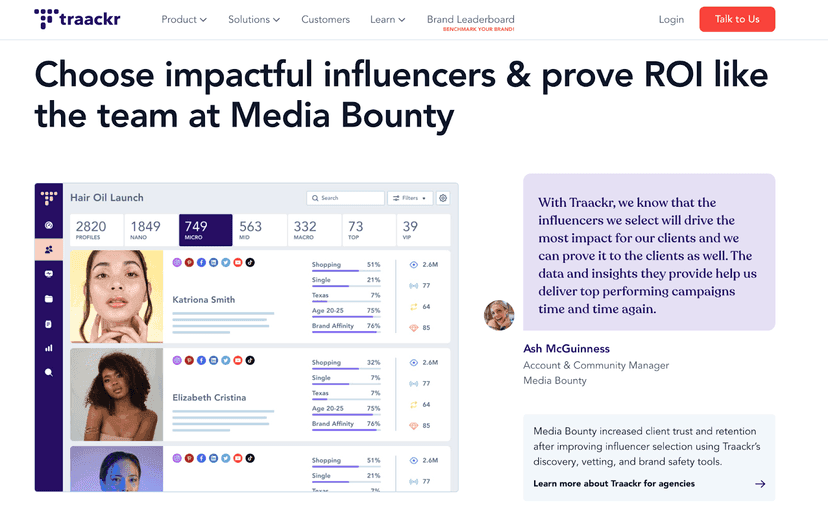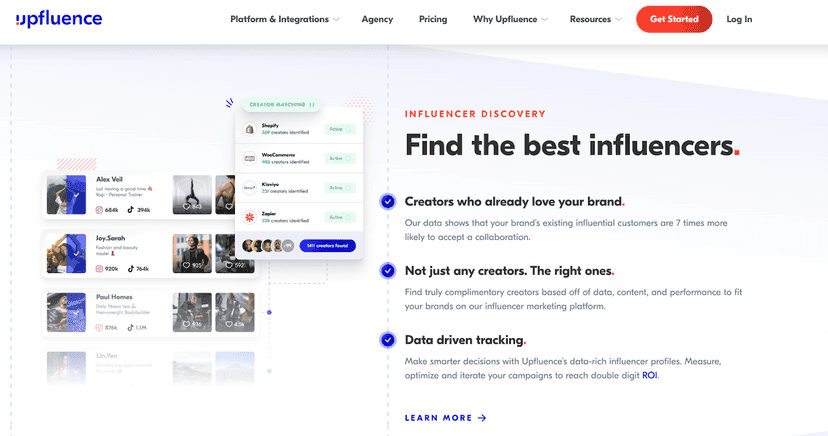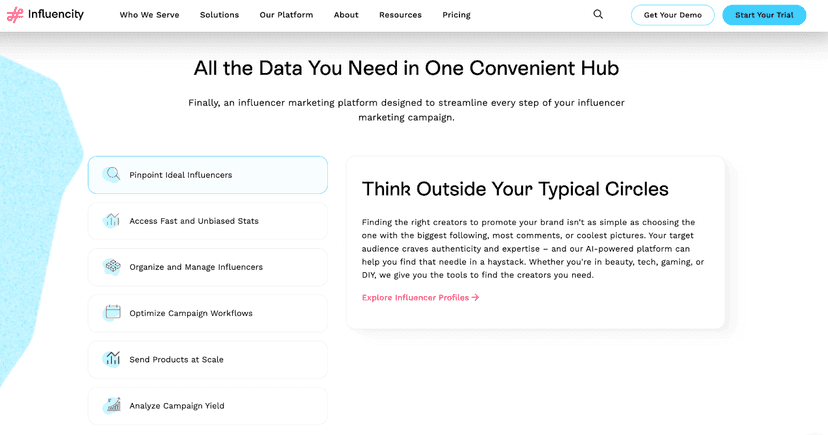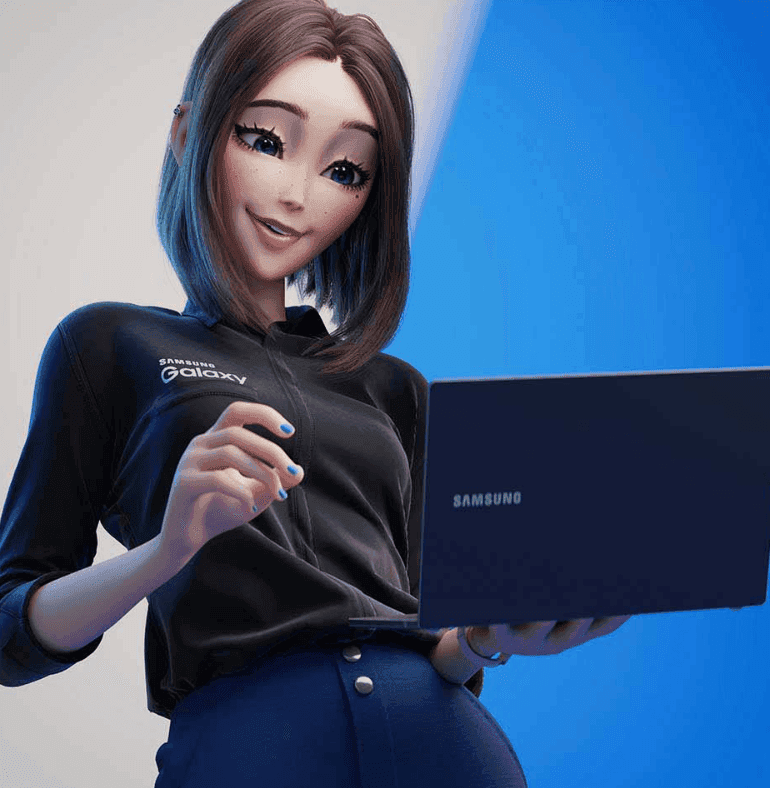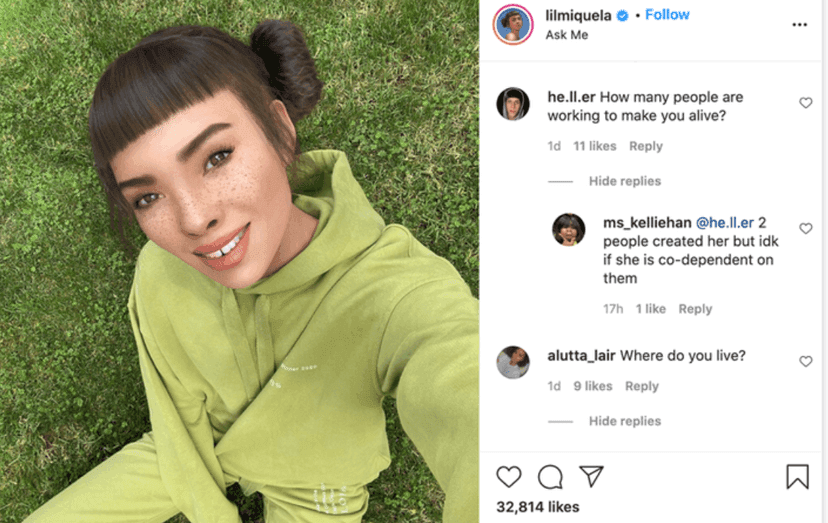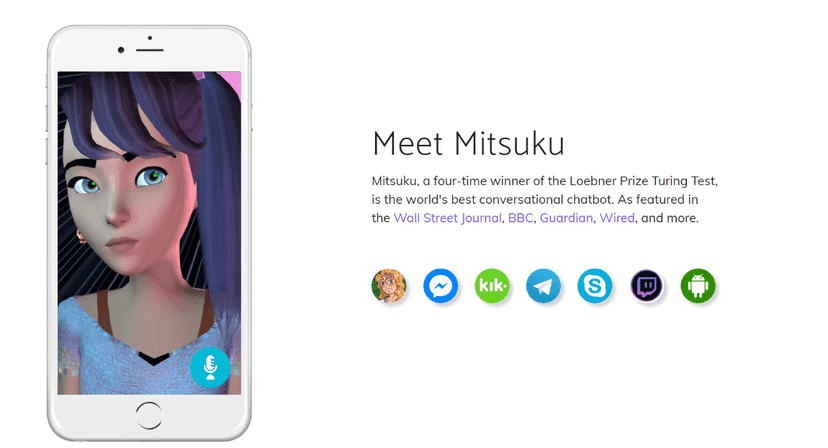Traditional marketing strategies are rapidly changing to keep up with the pace of social media and AI.
Influencer marketing is no different. AI can help brands engage with influencer campaigns in a way that they haven’t before. From precise influencer discovery to data-driven content and optimization, AI is empowering brands to unlock new levels of efficiency in their influencer campaigns.
What Is AI Influencer Marketing?
AI influencer marketing uses AI technology to make influencer marketing campaigns more effective. Influencer marketing involves working with people with a strong online presence to promote products or services.
With AI technologies, marketers can unlock new opportunities for collaboration, creativity, and growth in the dynamic world of influencer marketing.
How AI Enhances Influencer Campaigns
AI is a pretty special tool for enhancing your influencer campaigns, and your marketing in general. Here’s a list of ways AI can streamline your campaigns:
- Audience Segmentation And Targeting & Personalization: AI algorithms can analyze large amounts of data to identify and segment target audiences more effectively. AI can help influencers tailor their content to reach the right audience by understanding demographics, interests, and behaviors.
- Content Optimization: AI tools can analyze engagement data to determine which types of content perform best with specific segments. This information can help influencers create content that is more likely to resonate with their followers, which leads to higher engagement and better campaign results.
- Campaign Optimization: AI algorithms can continuously monitor and optimize influencer campaigns in real time.
- Fraud Detection: AI can help identify fake followers, engagement manipulation, and other forms of influencer fraud.
- Sentiment Analysis: AI-powered sentiment analysis tools can analyze social media conversations to understand how audiences perceive a brand or product.
Analyze Audience Demographics & Behavior
In AI influencer marketing, it’s crucial to know your audience. AI tools analyze demographics, behaviors, and preferences, offering insights for strategic influencer partnerships and personalized content, ensuring effective audience engagement.
Optimize & Personalize Your Content
In the era of information overload, personalized content stands out. AI influencer marketing uses machine learning to tailor content to the unique interests and behaviors of individual audience members. By analyzing engagement data, AI can suggest modifications to content, such as the tone, style, and topics that will resonate most with your audience.
This personalized approach not only enhances the relevance of your content but also strengthens the connection between your brand and its followers. Influencers, equipped with AI-generated insights, can create content that builds trust and loyalty.
Tailor Content To Audience Preferences
The final step in leveraging AI for influencer marketing is to ensure that every piece of content is crafted to meet the preferences of your audience. AI can help predict which content formats and creative elements will yield the highest engagement, from video length to hashtag usage.
By learning from audience interactions, AI can guide influencers in creating content that not only aligns with your brand’s message but also appeals to the audience’s evolving tastes. This dynamic approach to content creation is key to maintaining a compelling influencer marketing campaign.
AI Influencers: The Future Of Influencer Marketing
Could AI influencers be the future of influencer marketing?
First off, let’s talk about what an AI influencer is. Think of it as a virtual persona. They can be created through a combination of AI technology and creative input from developers, designers, and content creators.
Here’s a simplified overview of how the process of developing an AI influencer could work:
- Design & Development: First, developers design the AI influencer’s appearance, personality, and characteristics. This involves creating a virtual avatar or character using computer graphics software. They also develop the underlying AI algorithms that will drive the influencer’s behavior interactions.
- AI Training: The AI influencer’s algorithms are trained using large datasets of human behavior, with social media interactions and language patterns. This training process teaches the AI to emulate human-like behaviors, including speech, gestures, facial expressions, and personality traits.
- Content Creation: Once the AI influencers’s framework is in place, content creators and writers collaborate to develop engaging content, including posts, videos, and interactions. They script conversations, plan photo shoots, and create multimedia content to be shared on social media platforms.
- Integration With Social Media: Make sure that your AI influencer can easily integrate with your social media channels to make your marketing content efficient. If Instagram is your primary social media, you’ll want to make it so that your influencer fits in well with that audience.
Companies are starting to experiment with AI and AI generated influencers. This could be a game changer, and there’s a real possibility that AI generated influencers could become normal someday.
AI-Powered Influencer Identification Tools
AI influencer identification tools use advanced algorithms and machine learning techniques to analyze social media data and identify potential influencers for a given campaign.
Here are three tools you can use to help find the most suitable influencers for your brand.
Traackr
Key features of Traackr:
- Influencer Discovery: Find the right voices for your brand with advanced search capabilities and detailed analytics.
- Relationship Management: Build lasting connections with key influencers through efficient communication and management tools.
- Content Collaboration: Work closely with influencers to create compelling content that resonates with your target audience.
- Product Seeding: Seamlessly integrate with Shopify to send products to influencers, ensuring maximum impact and minimal waste.
- Campaign Management: Oversee every aspect of your campaigns with tools for tracking, reporting, and optimizing performance.
By integrating Traackr into your AI influencer campaigns, you can expect a collaborative and efficient approach. Enhance your engagement and visibility, and optimize your marketing strategies with the innovative solutions offered by Traackr.
Upfluence
Key features of Upfluence:
- Influencer Search: Utilize advanced search filters to identify influencers that align with your brand values and campaign goals.
- Analyze Influencers: Access in-depth analytics to evaluate influencer performance and audience demographics.
- Workflow and Outreach: Streamline your influencer outreach with automated tools that save time and enhance productivity.
- Influencer Gifting: Simplify product seeding with a streamlined process for sending gifts to influencers.
- Campaign Analytics: Measure the ROI of your influencer campaigns with real-time data and actionable insights.
With Upfluence, you gain access to a suite of powerful tools designed to optimize your influencer marketing efforts. If you’re looking to increase brand awareness, drive sales, or boost engagement, Upfluence is the right choice for you.
Influencity
Key features of Influencity:
- Effortlessly locate and connect with influencers
- Analyze potential influencers with in-depth metrics
- Use AI to predict campaign performance
- Track your campaigns with Influencity’s intuitive dashboard
Influencity can streamline your influencer campaigns and select the right influencer for you and your team.
Step-by-Step Guide For Implementing AI In Your Influencer Campaigns
1. Identify Campaign Objectives & Goals
Before diving into the world of AI-driven influencer marketing it’s crucial to establish clear campaign objectives. Are you aiming to boost brand awareness, drive sales, or engage a new audience segment?
Setting specific, measurable, achievable, relevant, and time-bound (SMART) goals will provide a solid foundation for your campaign and guide your AI tools toward success.
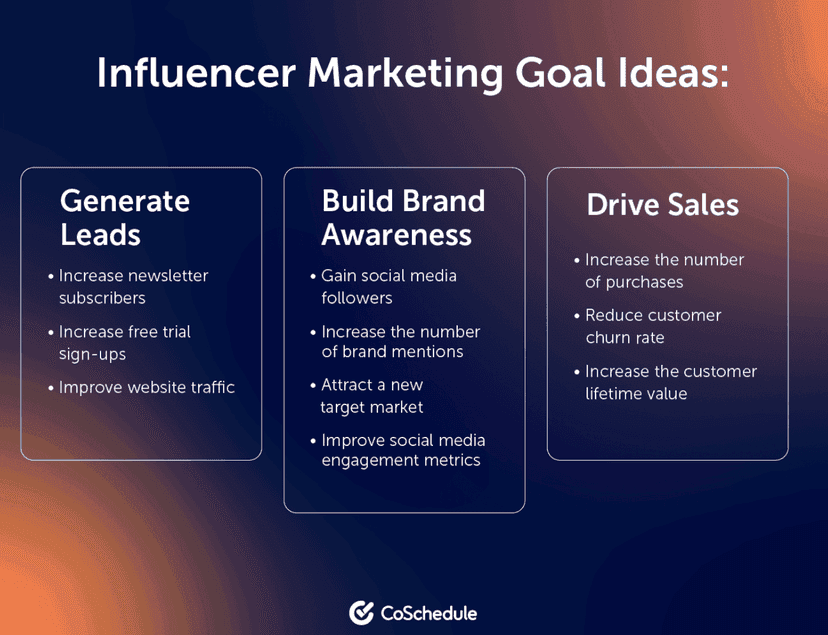
This graphic calls out different ideas you can keep in mind when you’re working on your influencer marketing goals.
Consider your brand’s overall marketing strategy and how influencer collaborations can complement your efforts. Whether it’s increasing social media followers or enhancing customer loyalty, your objectives should align with your brand’s long-term vision and values.
2. Collect Data & Analyze
Collect data on your target audience, including demographics, interests, and online behavior, to inform your AI algorithms. This data will help in identifying the influencers who resonate most with your audience.
Use AI tools to analyze this data and uncover patterns and insights. For example, predictive analytics can forecast the potential reach and engagement of your campaign, allowing you to make data-driven decisions and optimize your influencer selection process.
3. Collaborate With Influencers
With your objectives set and data in hand, it’s time to collaborate with influencers. AI can assist in this process by matching your brand with influencers who have the right audience and content style. Look for synergy between the influencer’s brand and your own, ensuring authenticity and a natural fit.
AI tools can also streamline communication and campaign management. From initial outreach to tracking post-performance, AI can help manage the logistical aspects of influencer partnerships, leaving you more time to focus on creative collaboration.
4. Create Content & Optimize
Content is king in influencer marketing, and AI can take your content creation to the next level. AI-powered content tools can suggest topics, and headlines, and even assist in writing drafts that influencers can personalize. This ensures content is not only engaging but also optimized for SEO and social media algorithms.
5. Monitor Your Performance & Adapt Accordingly
Monitoring your performance after implementing an AI influencer campaign is the best way to measure your success, and see what’s working and what isn’t.
Challenges And Considerations When Using AI For Influencer Marketing
Although AI is a powerful tool that marketers can benefit from, some challenges may come with AI that should be considered.
Ethical & Transparency Concerns
When using AI, it’s important to focus on fairness and clear communication. We must apply ethical standards to AI systems to ensure they treat everyone justly and are accountable for their actions. Understanding how AI makes decisions is key to building trust and making sure everyone, from users to stakeholders, is on board.
Ensuring AI is used ethically requires guidelines to prevent bias and discrimination. Organizations should aim for AI systems that are fair and transparent. Transparency in AI operations is crucial for users to understand its impact on outcomes.
Data Privacy & Security
Because of all the personal and sensitive data being processed, AI systems must be designed with robust security measures to protect against breaches and unauthorized access. Data privacy regulations, such as GDPR, impose strict requirements on data handling, and AI systems must comply with these standards to safeguard user privacy.
Embracing these challenges and considerations is not only a regulatory compliance matter but also a commitment to responsible innovation. By addressing ethical concerns and prioritizing data privacy and security, organizations can build AI systems that earn the trust and confidence of their users.
Examples Of AI Influencer Marketing
Let’s take a look at how other companies have not only used AI with their influencer marketing but have created AI influencers to do their marketing.
Louis Vuitton
Louis Vuitton made Lightning, their virtual model in 2016. This marked Louis Vuitton’s inaugural large-scale luxury marketing initiatives exclusively targeting the Asian market. Although she isn’t very common in Western regions, she is very popular in the Eastern markets.
Samsung
Samsung created Samsung Sam, which is designed to assist users with various inquiries related to Samsung’s products and services. Users can interact with Sam through Samsung’s website or social media channels, where she provides helpful information, troubleshooting assistance, and product recommendations.
Lil Miquela
Lil Miquela is a virtual influencer and digital character created by the Los Angeles-based startup Brud. Introduced in 2016, Miquela gained widespread attention on social media platforms like Instagram for her lifelike appearance and creative persona.
Despite being a computer-generated character, Miquela has amassed a significant following and has been involved in various marketing campaigns, fashion shoots, and music projects.
Balenciaga
In its Spring 2019 look, the brand used elastic virtual models crafted by visual artist Yilmaz Sen, based in Copenhagen. Similarly, for its fall 2021 collection, the French label adopted Unreal Engine’s video game Afterworld: The Age of Tomorrow as a platform to display its designs.
Mitsuku
Mitsuku is an advanced conversational artificial intelligence chatbot developed by Steve Worswick. It is renowned for its exceptional natural language processing capabilities and its ability to engage users in meaningful and human-like conversations.
Users can interact with Mitsuku on various platforms, including its website and messaging apps like Facebook Messenger.

